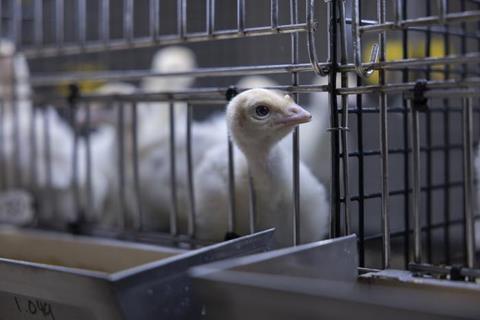As scientists learn more about a deadly parasite’s ability to move from host to host in turkey flocks, a long-standing theory is in question and opens the door to new preventative measures.

Histomonas meleagridis, the parasite behind histomonosis — also known as blackhead disease — can decimate flocks of turkeys. There are currently no U.S. Food and Drug Administration-approved vaccines or therapeutics to treat the birds.
READ MORE: Study supports disease-challenged broiler chickens through nutrition
“Mortality in turkey flocks can reach up to 80 percent,” said Danielle Graham, an assistant professor of poultry science for the University of Arkansas System Division of Agriculture. “Chickens are a little less susceptible to the disease, but they can still become infected. You just don’t see the extensive mortality that we do in turkeys.”
Fighting histomonosis
Graham, who conducts research through the Division of Agriculture’s Arkansas Agricultural Experiment Station, and Zhicheng Dou, associate professor in the biological sciences department at Clemson University, were recently awarded $3.2 million over five years from the U.S. Food and Drug Administration to support their work in developing insights about disease transmission and potentially finding an existing FDA-approved drug to fight histomonosis.

The FDA’s funding comes in the form of a cooperative partnership through the establishment of an Animal and Veterinary Innovation Center. According to the FDA, these centers aim to address urgent animal, human or environmental health needs. The center in Arkansas is one of four that FDA announced in September.
Turkeys accounted for $614 million in cash farm receipts for Arkansas in 2022, according to the latest Arkansas Agriculture Profile. Arkansas is third in national ranking of turkey production, the latest U.S. Department of Agriculture Turkeys Raised report states. Minnesota and North Carolina are ranked first and second, respectively.
Evolving theory of transmission
Two therapeutic classes of drugs, nitroimidazoles and nitrofurans, were previously used to mitigate histomonosis in poultry. However, the FDA banned their use in animals bound for human consumption due to concerns of carcinogenic residues. The last remaining drug approved for histomonosis control, nitarsone, was voluntarily removed from the market in 2015 due to other consumer health concerns. As a result, histomonosis cases have drastically increased, and this disease is now one of the top concerns for commercial turkey producers in the lower Midwest and Southeast United States, Graham said.
Preliminary studies by Graham and Dou, funded by USDA, provided supporting evidence leading to the FDA grant. The researchers showed that H. meleagridis can survive the lower pH of the turkey’s digestive tract and form cyst-like structures, a common survival strategy for protozoan pathogens to facilitate transmission. Developing inhibitors against this stage, Graham said, could be pivotal in controlling infections.
“Over the last 50-plus years, the thought was that histomonosis could only be efficiently transmitted outside of a host by a vector, whether that was a nematode called Heterakis gallinarium, or within an earthworm as a paratenic host for the nematode’s eggs,” Graham said. “But in turkeys, that nematode doesn’t reproduce efficiently. So, it doesn’t make sense for it to be the primary way for these protozoa to transmit in a turkey flock.”
Paratenic host
A paratenic host is a transport host in a parasite’s life cycle where the parasite survives but does not reproduce.
Graham said several infection and transmission routes for H. meleagridis in commercial poultry flocks have been proposed. The going theory has been that the parasite makes its way to the lower gastrointestinal tract by cloacal contact with parasite-containing feces or cloacal-to-cloacal contact with an infected host. It is unclear, however, whether this type of contact in the absence of a vector such as the nematode is sufficient for rapid and sustained transmission in commercial turkey flocks. In birds, including male and female turkeys, the cloaca is the exterior connection to the digestive, urinary and reproductive systems.
Since it is common for avian species to consume fecal matter, and the researchers demonstrated the parasites can survive low pH environments, Graham’s preliminary research shows there is potential for a fecal-oral route of transmission via contaminated feces or cecal droppings in the absence of a vector, likely due to the cyst-like formation, which is the focus on the FDA-funded project. The cyst serves as a sort of suit of armor to protect the parasites as they make their way to their target area, where they morph back into a form that allows them to feed and multiply.
Edge of knowledge
“We’re kind of at the edge of what’s known about H. meleagridis,” Graham said. “Zhicheng, my collaborator at Clemson, has been willing to explore the unknown related to cyst-like formation, fecal-oral transmission and even vaccine development with me. It has been an extremely productive and exciting collaboration, and I truly look forward to seeing what we learn throughout this project.”
Graham teaches courses through the Dale Bumpers College of Agricultural, Food and Life Sciences at the University of Arkansas and is affiliated with the Center for Excellence for Poultry Science. The center is part of the Division of Agriculture and Bumpers College, performing the three land-grant missions — teaching through Bumpers College, research through the experiment station, and extension through the Division of Agriculture’s Cooperative Extension Service.







No comments yet